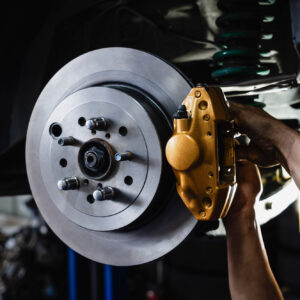By-wire systems are growing more advanced and more common in the automotive industry, thanks to the rise of electric vehicles (EVs) and hybrids. With technology quickly progressing, it’s time to ask, “Are these new by-wire systems trustworthy?” Brake-by-wire systems in particular are likely to spur this line of questioning due to their very important role. So today we’ll take a look at brake-by-wire systems, how they function, and what their advantages and drawbacks are.
What Is a Brake-by-Wire System?
In a brake-by-wire system, there’s no mechanical component connecting the brake pedal to the brakes themselves. Brake-by-wire, also known as electronic actuation, instead manages a vehicle’s brakes electronically via a series of sensors and motors. This allows vehicle manufacturers to trim some fat in their vehicles’ braking systems by replacing certain hydraulic components. While these components once connected the brake pedals to the rest of the braking system, they become obsolete in a brake-by-wire system.
Certain forms of brake-by-wire, such as hold assist and electronic parking brakes, are already in effect in various vehicles. This article focuses on brake-by-wire systems that engage the brakes when a driver depresses the brake pedal.
How Does Brake-by-Wire Work?
When you press on the brake pedal in a brake-by-wire vehicle, two sensors pick up this action. The first is a travel or position sensor, which detects how far you’re pushing the brakes. The position sensor connects to a simulator, which in turn simulates the feel of a traditional hydraulic brake system by creating resistance when you step on the brakes. The simulator adjusts the resistance level based on how far you’ve depressed the pedal. Drivers rely on this kind of feedback from traditional hydraulic brakes to brake properly, which is why mimicking it in a brake-by-wire system is so important.
The position sensor also signals the driver’s intended braking power to the rest of the brake-by-wire system. The more depressed the pedal, the more braking power the system provides, just like in a traditional system. Readings from the position sensor help the rest of the system determine whether to rely on the electric motors alone to slow down the vehicle or if it’s time to engage the mechanical disk brakes.
The system engages the mechanical brakes once you depress the brake pedal far enough and the system recognizes that you need a significant amount of braking power. It sends signals to an electric pump, which creates pressure to engage the hydraulic brakes.
If the system fails at any point, there’s a sensor for that as well. When this sensor picks up that the brake-by-wire system is failing, it opens a valve that pushes the pressure from the brake pedal to the individual brake pads. This fail-safe allows you to stop the vehicle in the event of electronic failure.

Advantages and Disadvantages of Brake-by-Wire Systems
Like all by-wire systems, brake-by-wire has its fair share of advantages and drawbacks. Learning about both can help you determine if brake-by-wire systems are worth trying.
Advantages
Brake-by-wire systems cut a vehicle’s weight down significantly. Having wires and sensors in place instead of a more complex set of hydraulics will save a lot of space in the car body. In addition, because brake-by-wire has been used in most hybrids since 1998, it’s actually much more reliable than conventional brake systems.
Engineers can also tune electronic brakes more easily. They can set brake-by-wire systems to be more relaxed in heavy traffic and more sensitive on a track. Pedal travel also remains the same, no matter how hard the brakes are working. You’ll always feel consistent resistance from the simulator. Instead of having to press harder when you need more braking power, you’ll simply need to depress the pedal the adequate distance and let the electric pump do all the work.
Once brake-by-wire technology evolves to no longer need hydraulics, it’ll cut out hydraulic fluid from the process entirely. This’ll make production easier for the manufacturers and maintenance easier for you.
Disadvantages
Many people worry whether modern brake-by-wire cars are safe. After all, they rely on electronics that might glitch or fail, and this is the last thing you want. Thankfully, as we’ve mentioned, brake-by-wire systems come with various redundant sensors that measure the system’s different aspects and functions. If the sensors catch anything out of the ordinary, they’ll engage the emergency hydraulic connection, allowing the driver to brake regardless of a partial or full system failure.
Which Cars Have Brake-by-Wire Systems?
Brake-by-wire has evolved enough that manufacturers have started integrating it heavily into some of their vehicles. Most common hybrid vehicles from Toyota, GM, and Ford have been using brake-by-wire since 1998. Chevrolet’s installed brake-by-wire in their C8 Chevrolet Corvette and various models like the Buick Encore GX, Chevrolet Trailblazer, and Cadillac CT4, CT5, and XT4 lines.
Audi’s e-tron, Porsche’s Taycan, and Alfa Romeo’s Stelvio and Giulia also use brake-by-wire. In addition, Toyota and Lexus are also now integrating this technology into their vehicles.
Hesitation is to be expected when adopting a new system as revolutionary as brake-by-wire. Now that you’re familiar with how it works and the safeguards in place, it’s your call whether to accept brake-by-wire into your driving life. Worse comes to worst, you’ll still have hydraulic brakes to rely on, at least for now.
Get a Replacement Brake Pedal Today
Regardless of the type of brake system, your brakes should always be in good condition. Driving around with a faulty brake pedal can eventually lead to brake failure, which will most likely cause an accident. For your own safety, it’s best to stop driving until you replace your brake pedal. Luckily, getting a replacement brake pedal is fast and easy with CarParts.com.
CarParts.com offers a wide selection of high-quality brake pedals that are sourced from only the most trusted manufacturers in the industry. We want you to have a hassle-free shopping experience, so we’ve made things easier with our built-in vehicle selector. Simply enter your vehicle’s year, make, and model to browse through all the available brake pedals that are compatible with your ride. We also provide accurate and detailed fitment information for each part, so you can rest assured you’re getting a brake pedal that fits your car.
Don’t wait until your brake pedal fails and causes an accident before replacing it. Check out our selection of high-quality brake pedals at CarParts.com and order one today!
Any information provided on this Website is for informational purposes only and is not intended to replace consultation with a professional mechanic. The accuracy and timeliness of the information may change from the time of publication.


















